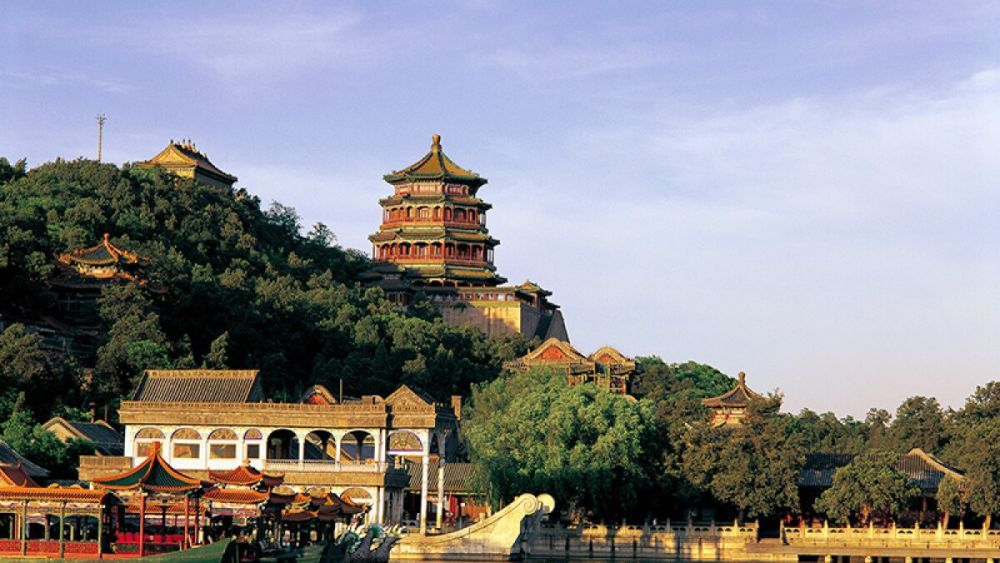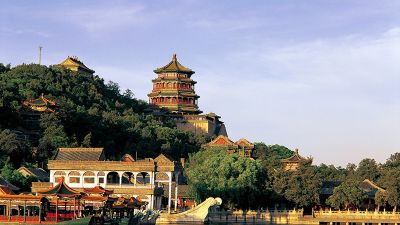

Kunming Lake, occupying most of the Summer Palace, is a key feature that offers visitors a serene and majestic view of traditional Chinese landscape design. The man-made lake, complemented by the surrounding hills and elaborate architectural structures, was designed to imitate the natural scenery of the West Lake in Hangzhou. Exploring the lake can be done on foot or by taking a leisurely boat ride. Along the lake's edge, a long corridor decorated with more than 14,000 traditional Chinese paintings ensures that there is beauty to be seen in every step. This activity not only provides a peaceful retreat from the bustling city of Beijing but also offers insight into the luxurious lifestyle of the Qing dynasty as well as the intricate craft of ancient Chinese waterworks and garden design.
Longevity Hill is a prominent hill within the Summer Palace, renowned for its beautiful landscapes and stunning, palatial buildings that line its slopes. As visitors climb the hill, they encounter various halls, pavilions, temples, and gates, each with its own history and significance. The climb culminates at the Tower of Buddhist Incense, which stands as the highest point in the Summer Palace, offering a panoramic view of the entire royal park and Kunming Lake. The hill is beautifully adorned with an array of plants and trees, making it especially picturesque in the warmer months. Exploring Longevity Hill provides a comprehensive historical tour through the opulence and aesthetics of imperial China, reflecting centuries-old architectural styles and religious influences.
The Grand Hall of Benevolence and Longevity is one of the key structures within the Summer Palace where the Empress Dowager Cixi would hold court and receive officials. Visitors can step back in time as they walk through the hall, admiring its exquisite interiors and regal furnishings. The surrounding courtyards and gardens are meticulously maintained, showcasing traditional Chinese horticulture. Exhibits often feature period artifacts and give detailed narratives of the palace's extensive history. This tour provides a deeper understanding of Chinese imperial governance and offers a glimpse into the opulent lifestyle of the Qing emperors and their courts.
The Long Corridor at the Summer Palace is an iconic gallery that stretches roughly 728 meters along the northern shore of Kunming Lake. This covered walkway is famed for its intricate paintings that depict scenes from Chinese literature, historical events, and landscapes, totaling more than 14,000 individual scenes. As visitors stroll through the corridor, they can enjoy the shade and the leisurely atmosphere while being sheltered from the elements. The Long Corridor ends at the Marble Boat, another remarkable sight in the palace. The stroll is not just a walk but a journey through Chinese art and culture, as each painting has a story to tell, enhancing the cultural value of the leisurely walk.
The Garden of Virtue and Harmony is a tranquil and elegant retreat located in the northeastern corner of the Summer Palace. It was constructed as an entertainment venue for the Empress Dowager Cixi and features three stories of theaters including the largest wooden theater in China. The garden is not only a cultural hotspot but also a horticultural one, with a rich variety of flowers and trees that provide a colorful display. Visitors can explore the pavilions and halls that surround the theater, marveling at the ornate decorations and the rich history behind this luxurious imperial playground. The landscaped garden areas are harmoniously designed to evoke the essence of peace and balance.
Take the opportunity to relax and paddle across the tranquil waters of Kunming Lake. This experience allows you to enjoy the Summer Palace from a different perspective, away from the crowds, and more closely connected to nature. The lake’s calm waters reflect the surrounding palaces, pavilions, and the vast sky above, creating a picture-perfect setting. This activity is especially enjoyed by families and couples seeking a romantic outing. Paddle boats are available for rent at various locations around the lake, and lifejackets are typically provided for safety. Paddle-boating on the lake is a refreshing way to appreciate the grandeur of the Summer Palace and its harmonious blend with nature.
Located on the southwestern slope of Longevity Hill, the Four Great Regions is a Tibetan-style temple complex modeled after the Samye Monastery, Tibet's first monastery. The complex is a striking example of the religious and cultural integration within the imperial palace. Climbing up the temple offers a unique glimpse into the Buddhist influences that permeated the Qing dynasty. The architecture, with its distinct Tibetan elements, stands out amidst the predominantly Han Chinese style of the rest of the palace. Once at the summit, visitors can take in the picturesque views and learn about the fusion of different Buddhist traditions within Imperial China.
The Seventeen-Arch Bridge is a famous landmark that spans the eastern end of Kunming Lake, connecting the eastern shore with Nanhu Island. It is the longest bridge in the Summer Palace and a prime location for photography enthusiasts. The bridge’s unique construction, consisting of 17 arches with a stately lion statue adorning each of the 544 balusters, creates a picturesque setting that is particularly stunning during sunrise and sunset. Capturing the reflections of the arches on the water, the surrounding landscapes, and the harmonious blend of nature and architecture is a delight for both amateur and professional photographers. A photography tour of the bridge will not only allow visitors to take memorable pictures but also appreciate the detailed artistry and symbolic meanings embedded within its structure.
Suzhou Street, situated at the backside of Longevity Hill alongside the Back Lake, is designed to mimic the water towns found in the Jiangnan region of China. This area of the Summer Palace was originally built for the royal family to enjoy shopping and feel the atmosphere of the bustling market streets without leaving the palace. As visitors walk down the street, they can see shops and stalls selling traditional Chinese handicrafts, art, and snacks. The cobblestone paths and waterfront setting provide a charming backdrop for exploration and photography. Beyond the street is the Back Lake, a peaceful area where one can enjoy a quieter side of the palace, often less crowded and providing a contemplative contrast to the grandeur of the main palace complex.
The Summer Palace is not only a historical site but also a living cultural center where visitors can engage in a variety of traditional Chinese cultural workshops. These activities can range from Chinese calligraphy and painting to silk embroidery and kite making. Such workshops provide hands-on experience and deeper cultural immersion, allowing guests to learn from skilled artisans and take home their own creations as souvenirs. Workshops can be found at various locations within the palace grounds and can offer a delightful educational break from sightseeing, providing a meaningful connection with Chinese heritage and artistic traditions.
